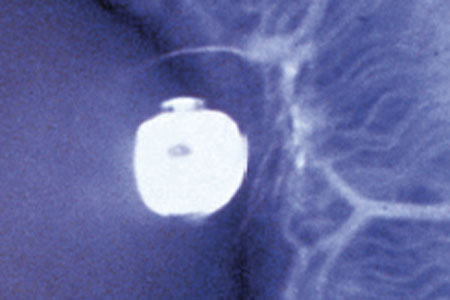
Cataracts: What The Eye can see
Issue 7 Sept / Oct 2004
When people find out they have a cataract they are usually fearful for their eyesight. However, it is a very common condition and approximately half of over 65s have developed a cataract in one or both their eyes to a varying degree. Those over 80 years of age have noticeably had their vision affected by cataracts. It is the commonest cause of blindness worldwide – and also the most easily treated.
Behind the coloured part of the eye (iris) is the lens of the eye. The lens works by helping images focus on the back of the eye (the retina). A cataract occurs when this lens becomes clouded. The process by which the lens becomes hardened is known as sclerosis. As this happens, vision is affected.
The most common symptom of cataracts is blurring or misting of vision. Fading of colour vision can also occur. The effect of the cataract can also cause light to scatter on the back of the eye causing particular problems to night time driving with oncoming headlights. The symptoms are gradual and occur over years – therefore the deterioration in vision is hardly noticeable. Some people find that they start to wear stronger strength glasses but this is a temporary solution. With time, it can also affect the ability to drive. Cataracts are a consequence of the normal ageing process but can be suffered earlier by people with diabetes or those on steroid tablets. Other known causes are smoking and excess sunlight exposure. There are also some genetic causes of childhood cataracts. The rubella vaccination for mothers is one way of preventing cataracts that occur at birth. There is no confirmed way of avoiding cataracts that develop with age. Some specialists believe that protection of the eyes from bright sunlight may help. Cataracts are not usually visible by other people. Rarely, advanced cataracts show up as a white pupil. Cataracts are diagnosed by an ophthalmologist (eye specialist) by using a specialist microscope called a slit lamp.
There is a simple operation that can remove the cataract. There is no evidence for diet or drugs to cure or slow the progression of cataracts. Usually the cataract is removed when sight impairs activities of daily living significantly. The operation is often done under local an aesthetic and is relatively straightforward, taking 15-20 minutes. This procedure is known as phacoemulsifi cation. A small incision is made in the eye and the lens containing the cataract is removed by liquefying the lens. An artifi cial plastic lens implant is then put in its place. Occasionally laser treatment may be done subsequently. The majority of people notice an instant change to their vision although eye drops have to be used for a couple of months afterwards.
Abdul Jabbar Umar, aged 53, gives an insight into problems that he has experienced with his eyes, a problem that started approximately seven years ago. "I started to wear glasses when I was only 10 years of age for my short-sightedness. As I got older I started to use contact lenses instead. There is a family history of short sightedness in my family and I got used to using glasses or contact lenses to aid my vision.
Over a period starting about seven years ago, my vision gradually started to deteriorate. Initially my opinion was that it was just a normal process associated with the worsening of my short sightedness. But about three years ago my eyesight became particularly poor and I found it very hard to focus on objects. I made several visits to my optician and my eyesight prescription kept changing and I was given increasing strengths of lenses. At its worst, as well as wearing my normal contact lenses I had to start wearing my glasses to maintain my vision and even then my sight was poor. The main problem was blurring and this was quite concerning. As well as the blurring I started to get small dots drifting in my vision. I was told that these were floaters and were quite common. When these floaters started to increase I became more worried.
I made an appointment to see my optician who, after checking my eyes, referred me to the local ophthalmologist at the hospital. After the consultation I was not given a firm diagnosis as to what the problem with my eyes may have been and this was causing me quite a lot of worry, especially as my eyesight was deteriorating. With the deterioration of my eyesight,
I found that the most difficult task was managing at work. This affected me greatly. As I work with numbers, I had to concentrate harder to read and the pace at which I worked slowed down. It was important that I did not make mistakes and I had to adjust my working environment. At home, my family understood and supported me through the problems I was experiencing. There was not much that they could do to help directly, but they were there if I needed anything.
Eventually, after a year without a diagnosis I decided to leave the NHS and go private to see if I could be helped. It was no long before I was eventually diagnosed with cataracts in both my eyes. This was about two years ago. Even though it is part of a normal ageing process, the treatment for it is quick and relatively simple. Unfortunately, I had to fund my own treatment to speed up the process. I went to the Moorfi elds Eye Hospital in London, one of the leading centres for eye health.
Within three months I had both my eyes operated on and the cataracts dealt with. After this I had a further course of laser treatment on my eyes, to correct my vision. Thanks to God, I now possess 20/20 vision, and have only the occasional floater in my eyes. I have not been using either my contact lenses or my glasses. I feel like a young man again.
When things were not going well and I was left for over a year without a diagnosis I held on to my faith and told myself that whatever God had planned for me would be. I found that my faith really helped me get through the problem with my eyes. Everything is in faith."
Bookmark this |
|
Add to DIGG |
|
Add to del.icio.us |
|
Stumble this |
|
Share on Facebook |
|
Share this |
|
Send to a Friend |
|
Link to this |
|
Printer Friendly |
|
Print in plain text |
|


Comments
0 Comments